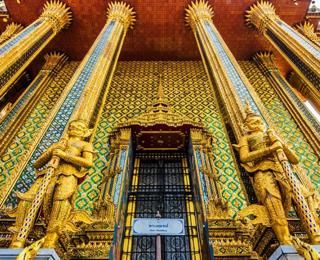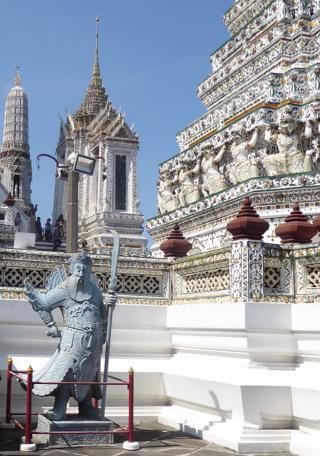Magnificent Mansions - The Grand Palace – Bangkok

The Grand Palace, located on the Chao Phraya River, was originally commissioned by King Rama I, in 1782 when Bangkok was designated as the new capital of what was then Siam (now Thailand).
It covers a large compound (as indicated on my visitor guide below) - dazzling golden temples, administrative buildings, throne halls and royal residences. A further 7 kings lived in the Grand Palace.

My imagination was captured as a teenager after seeing the Hollywood movie The King and I, where Deborah Kerr (in her role as a teacher of the King’s children), wearing a magnificent European ballgown, and Yul Brynner (in the role of the King of Siam), dressed in silk pantaloons and bare feet, waltzed around a grand ballroom.
The movie, based loosely on the novel of the same name, recounts the memoirs of Anna Leonowens, governess to the children of King Mongkut (King Rama IV) of Siam in the early 1860s. The plot relates the experiences of Anna, a British schoolteacher hired as part of the King's drive to modernize (or adopt western customs) in his country.
Hollywood had little regard for the facts and as a result the movie was banned in Thailand.

I suppose it was no wonder that Rama IX moved to Chitralada Royal Villa as an unofficial permanent residence after Rama VIII was stabbed in the palace in 1946!
Although the king and his family no longer live here, the grounds are still a very important, if not the most important place of Thailand, as it is home to Wat Phrae Kaew – the Emerald Buddha, the most significant Buddha of Thailand. The complex attracts both local and international tourists and is used to mark all kinds of other ceremonial and auspicious happenings.

I have visited The Grand Palace on at least 4 occasions, the first time in 1973 and most recently in 2019. I am always filled with wonder - the grounds are immaculate and each building is not only covered in intricate designs but a work of art in itself. Gold is the dominant colour, along with orange and green.

The impressive Royal residence (above) can certainly be considered a magnificent mansion. It was built in 1878, and following on from King Rama IV’s interest in Europe, King Rama V nominated an English architect to design the palace in an Italian Renaissance style, however he requested the rooftops and spires be in a typically Siamese style.
Although not open to the public it is notable for the richness of the interiors; all the rooms in the palace are treasure troves with valuable paintings and portraits of every Thai king. Along with relics there is also a shrine in which the ashes of the kings Rama IV, V, VI and their wives are kept.
The design makes the building stand out from the ones around it and while the mix in architectural styles seems incongruous, to my mind it seems to work.
The impressive topiary trees would be the envy of many a gardener!

As mentioned, the most sacred temple is that of Wat Phra Kaew, the Emerald Buddha - an exquisite statue of a meditating Buddha, made out of the semi-precious stone jade and dressed in gold robes — standing just 66 centimeters high, resting on a tall plinth beneath a nine-tiered canopy.
Scholars believe the figure was carved in Pataliputra in India, though other sources claim it to be from Burma and the work of an unknown artist. It first came to light in 1434 in Chiang Rai, northern Thailand, having arrived there by way of Ceylon (now Sri Lanka) and Cambodia.
At the time of its discovery, the statue was encased in plaster. While being transported, the casing was damaged and split open, revealing the figure within. The Buddha traveled a long way to end up in Bangkok in 1778, where it has been kept ever since. 3

The Emerald Buddha changes costume three times a year in winter, summer, and the rainy season. The summer and rainy season costumes were commissioned by Rama I (1737–1809). Rama III (1824–1851) had the third costume crafted for the winter season.
The changing ritual is performed solely by the king to bring good fortune to the country during each season. In summer, the king puts the robe with rubies on the Buddha. In winter, the robe is changed to the solid gold one. When it’s the rainy season, the Buddha is dressed in the robe with blue sapphires.6

Let’s look at a few other impressive buildings with a variety of styles. Photos are not permitted inside any of the buildings and I could not find examples on the internet; the exteriors alone though are a sight to behold.


Phra Mondop serves as the Palace library - made out of tiny green and gold glass mosaics, a gilt spire, and pure silver floors. Behind the beautiful mother-of-pearl doors, dragon imagery, and Ayutthaya-style architecture, rests the Canon of Buddha — sacred scriptures written on palm leaf — as well as a number of Buddhist publications and ancient literature.3
The Prasat Phra Debidorn building, also known as the Royal Pantheon, contains life-size statues of the kings of the Chakri dynasty. The building was originally designed to house the Emerald Buddha, but those plans were abandoned when the resulting construction was deemed too small.3


A perfect replica of Angkor Wat in Cambodia, the Khmer-style temple offers an interesting history lesson and a glimpse at the landmark as it was being planned. The model dates from the reign of Rama IV, when what is now Cambodia was a vassal state of Siam.3
Dusit Maha Prasat - The single large inner hall of this building, was originally Rama I's Audience Chamber. Here, the king received his guests, up on a niche-like throne set in the south wing wall. On the roof, a spire designed to look like the king's crown adds a royal touch to this Italian Renaissance meets Thai traditional hall.3

Aphorn Phimok Prasat – a small pavilion used by Rama I as a robing chamber. Here, the king would change before entering the audience room and then again after leaving. Drapes interlaced with gold thread were drawn around the pavilion pillars while the king donned his ceremonial robes.3
Isn't it exquisite?
This pavilion was also used to park the king's palanquin, a one-passenger human-powered form of transport—basically a large box or seat carried by six bearers on long poles. Before a ceremony, the king would change inside Dusit Maha Prasat before leaving in the palanquin to join the festivities. 3
Below are some of my photos showcasing some of the intricate work.


I was not able to ascertain how much gold is used on and in the buildings of the Grand Palace - but it must be a lot!
Don your sunglasses and enjoy a youtube clip which takes you around the opulent Palace.
In complete contrast, our next mansion will be a modest one, but close to my heart in my home town of Melbourne.
Credits:
1 askideas.com
2 Britannica.com
3 planetware.com
4 Flickr
5 pinterest
6 asiahighlights.com
7 buddhistdoor.net
